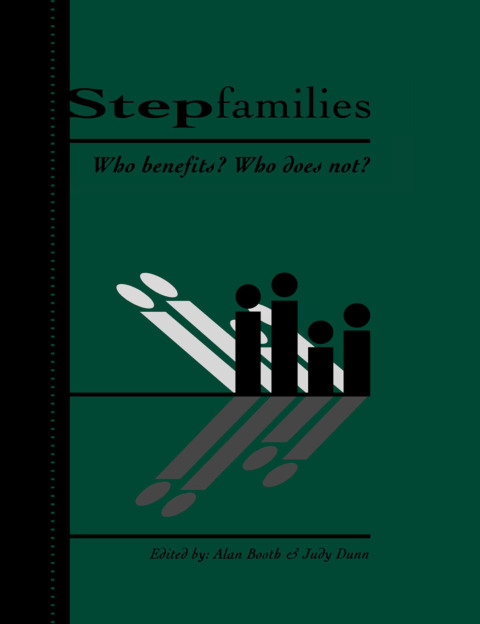Description
Efnisyfirlit
- Cover Page
- Half Title page
- Title Page
- Copyright Page
- Contents
- Preface
- Acknowledgments
- I Marriages that Create Stepfamilies—Why do they Occur? Fail? Succeed?
- 1 The Evolution of Marriage and the Problem of Stepfamilies: A Biosocial Perspective
- The Problem of Stepfamilies
- Biosocial Bases of Family Life
- Sexual and Reproductive Strategies
- Paternal Certainty
- Cultural Contexts
- Marriage and Divorce in Premodern Societies
- Marriage and Divorce in Urban-Industrial Societies
- Recent Family and Cultural Change in America
- The Social Response to Stepfamilies
- References
- 2 Stepfamilies in the United States: Challenging Biased Assumptions
- Statements Lacking Empirical Support
- Selective use of Research to Support a Theoretical Position
- Disregard of Stepfamily Complexity and Diversity
- Disappointing Aspects of the Chapter
- References
- 3 Remarriages and Stepfamilies Are Not Inherently Problematic
- Children of Stepfamilies have as many Behavioral and Emotional Problems as the Children of Single-Parent Families, and Possibly More
- Stepfamilies are more Unstable than Intact Families
- A Biosocial Perspective leads to the Conclusion that Stepfamilies are Intractably Problematic
- Family Life in the 1950s was better than Contemporary Family Life
- The Family is being Deinstitutionalized
- References
- 4 Biology, Evolutionary Theory, and Family Social Science
- The Utility of Biosocial Perspectives in Explaining Contemporary Behavior and Social Arrangements
- Is Stepparenting Inherently Problematic?
- Bringing Biology Back In
- References
- II How do Stepfamilies Function as Childrearing Organizations?
- 5 Stepfamilies as Settings for Child Development
- Challenges to Remarried Families
- Three Longitudinal Studies of Marital Transitions
- The Virginia Longitudinal Study of Divorce
- The Hetherington and Clingempeel Study of Divorce and Remarriage
- The National Study of Nonshared Environment
- Methods and Constructs
- Family Relationships
- The Marital Relationship
- Parent–Child Relationships
- Custodial Parents
- Stepparents
- Noncustodial Parents
- Children’s Behavior Toward Parents
- Links Between The Marital Relationship and Parent–Child Relationship
- Adolescence as a Sensitive Period for Stepfamilies
- Children’s Adjustment in Stepfamilies: Relationship to Parenting
- Siblings, Peers, and the School as Risk or Protective Factors
- Summary and Conclusion
- References
- 6 The Implications of Research Findings on Children in Stepfamilies
- References
- 7 “Settings” and “Development From a Demographic Point of View
- References
- 8 Understanding Why Children in Stepfamilies have More Learning and Behavior Problems than Children in Nuclear Families
- References
- III How do Stepfamilies Function as Sources of Support?
- 9 Stepfamilies Over the Life Course: Social Support
- Theoretical Frameworks
- Sociobiology: They’re not Carrying my Genes
- Social Psychological Perspectives
- Social Network Perspectives
- Institutionalization Perspectives
- Conclusion
- Empirical Findings
- Stepchildren During the Launching Phase
- Stepsiblings
- Relationships Among Adult Stepchildren and Stepparents
- Discussion
- Implications for Research and Theory
- Methodological Appendix
- Sample Information
- Measures
- Acknowledgments
- References
- 10 Conceptual and Methodological Issues in the Study of Stepfamilies Over the Life Course
- A Call for Better Data and More Description
- Remarriage as a Special Case of Role Transitions
- References
- 11 Stepfamilies: Selectivity of High-Risk Persons or Risk State?
- What is Parenthood?
- Is a Stepfather more than an Income Generator?
- The Father–Child Link
- Stepfamilies and Stepfamily Households
- The Selectivity Issue
- References
- 12 Intergenerational Ties in Adulthood and Childhood Experience
- Is The Difference between Step- and Original Families Real?
- Alternative Explanations
- Possible Bias in Sample Composition
- Variation among Stepfamilies
- Dimensions of Variation
- Another Look at Variation: Variation within Stepfamilies
- Stepfamilies and Public Policies
- Summary and Conclusion
- Acknowledgments
- References
- IV Building Research and Policy Agendas—What is Needed?
- 13 Research on Stepparenting Families: Integrating Disciplinary Approaches and Informing Policy
- Studying Household Arrangements and Parental Transitions
- Defining Stepparents
- Specifying Methodologies and Models
- Methodologies in the Study of Stepparenting
- Models Used in the Study of Stepparenting
- Processes Underlying Negative Outcomes of Children in Stepparent Families
- Economic Perspectives
- Psychological Perspectives
- Family Systems Perspectives
- Other Family Structures
- Non-Custodial Parents in Single-Parent and Stepparent Families
- Child Support Payments
- Effects of Child Support
- Changes in the Child Support System
- Conclusion
- Acknowledgments
- References
- 14 Reformulating the Legal Definition of the Stepparent–Child Relationship
- References
- 15 Social Policy Pertaining to Stepfamilies: Should Stepparents and Stepchildren Have the Option of Establishing a Legal Relationship?
- Principles that should Underlie Policy Initiatives
- A Policy Proposal: Stepparents and Stepchildren should have the Opportunity to Establish Legal Relationships with Each Other
- The English Policy
- Potential Advantages and Disadvantages of the Proposed Policy
- Research Questions that Need to be Addressed
- Conclusion
- References
- 16 Policies for Stepfamilies: Crosswalking Private and Public Domains
- Overview of Volume Goal
- Who
- Benefit
- Policy Implications
- References
- 17 Stepfamilies: An Overview
- Who Benefits and Who Suffers?
- Unexpected Findings
- Gaps in Research
- Methodological Considerations
- Policy Issues
- References
- Author Index
- A
- B
- C
- D
- E
- F
- G
- H
- I
- J
- K
- L
- M
- N
- O
- P
- R
- S
- T
- U
- V
- W
- Y
- Z
- Subject Index
- A
- B
- C
- D
- E
- F
- G
- H
- I
- L
- M
- N
- O
- P
- R
- S
- T
- V






Reviews
There are no reviews yet.